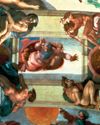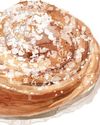
NOBLE, innocent, a fugitive from a fairy tale—there is something magical about a white deer. It’s unsurprising then, that this awe-inspiring animal features so widely in our folklore and literature. Celtic mythology saw the white deer, with its ghost-like appearance, as a sacred messenger from a supernatural realm, heralding change—a quest, perhaps —announcing a transgression or conveying a warning. The notion has endured for centuries. Five hundred years ago, on the Isle of Arran, it was believed that a white stag would materialise at Brodick Castle when the death of a Hamilton clan chief was imminent.
Pursued in vain by King Arthur’s court, the elusive white stag was the ultimate trophy, symbolising Man’s futile search for spiritual fulfilment and glory and exposing his vanity. Those who hunt the white stag are led deep into the woods away from safety and to kill it frequently unleashes chaos. Across time and space, Native American legend has it that a Chickasaw youth was never seen again after he shot a white deer in exchange for his sweetheart’s hand in marriage. The curse saw his beloved live out her days alone and forever haunted by an apparition of the white deer that, when the moon was full, would appear in the smoke curling from her campfire— pierced by an arrow, yet running still. Some even speculate today whether Archduke Franz Ferdinand’s shooting of a white deer in the autumn 1913 presaged his assassination the following summer and the years of bloodshed that ensued.
Denne historien er fra September 20, 2023-utgaven av Country Life UK.
Start din 7-dagers gratis prøveperiode på Magzter GOLD for å få tilgang til tusenvis av utvalgte premiumhistorier og 9000+ magasiner og aviser.
Allerede abonnent ? Logg på
Denne historien er fra September 20, 2023-utgaven av Country Life UK.
Start din 7-dagers gratis prøveperiode på Magzter GOLD for å få tilgang til tusenvis av utvalgte premiumhistorier og 9000+ magasiner og aviser.
Allerede abonnent? Logg på

A trip down memory lane
IN contemplating the imminent approach of a rather large and unwanted birthday, I keep reminding myself of the time when birthdays were exciting: those landmark moments of becoming a teenager or an adult, of being allowed to drive, to vote or to buy a drink in a pub.

The lord of masterly rock
Charles Dance, fresh from donning Michelangelo’s smock for the BBC, discusses the role, the value of mentoring and why the Sistine chapel is like playing King Lear

The good, the bad and the ugly
With a passion for arguing and a sharp tongue to match his extraordinary genius, Michelangelo was both the enfant prodige and the enfant 'terribile’ of the Renaissance, as Michael Hall reveals

Ha-ha, tricked you!
Giving the impression of an endless vista, with 18th-century-style grandeur and the ability to keep pesky livestock off the roses, a ha-ha is a hugely desirable feature in any landscape. Just don't fall off

Seafood, spinach and asparagus puff-pastry cloud
Cut one sheet of pastry into a 25cm–30cm (10in–12in) circle. Place it on a parchment- lined baking tray and prick all over with a fork. Cut the remaining sheets of pastry to the same size, then cut inner circles so you are left with rings of about 5cm (2½in) width and three circles.

Small, but mighty
To avoid the mass-market cruise-ship circuit means downsizing and going remote—which is exactly what these new small ships and off-the-beaten track itineraries have in common.

Sharp practice
Pruning roses in winter has become the norm, but why do we do it–and should we? Charles Quest-Ritson explains the reasoning underpinning this horticultural habit

Flour power
LONDON LIFE contributors and friends of the magazine reveal where to find the capital's best baked goods

Still rollin' along
John Niven cruises in the wake of Mark Twain up the great Mississippi river of the American South

The legacy Charles Cruft and Crufts
ACKNOWLEDGED as the ‘prince of showmen’ by the late-19th-century world of dog fanciers and, later, as ‘the Napoleon of dog shows’, Charles Cruft (1852–1938) had a phenomenal capacity for hard graft and, importantly, a mind for marketing—he understood consumer behaviour and he knew how to weaponise ‘the hype’.